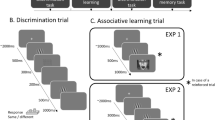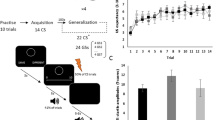Abstract
Animal studies of discriminative fear conditioning traditionally use stimuli that are distant in physical features and thus easily distinguished perceptually. Independently, human studies have shown that training mostly improves discrimination thresholds. We found that aversive learning actually induced an increase in discrimination thresholds in humans and that subjective aversion during conditioning predicted the individual threshold change. This counterintuitive performance deterioration occurred when using odors or sounds as aversive reinforcers and was not a result of attentional distraction or decision bias. In contrast, positive reinforcement or mere exposure induced the typically reported decrease in thresholds. Our findings indicate that aversive outcomes induce wider stimulus generalization by modulating perceptual thresholds, suggesting the engagement of low-level mechanisms. We suggest that for risk- or loss-related stimuli, less specificity could be a benefit, as it invokes the same mechanisms that respond quickly and efficiently in the face of danger.
This is a preview of subscription content, access via your institution
Access options
Subscribe to this journal
Receive 12 print issues and online access
$209.00 per year
only $17.42 per issue
Buy this article
- Purchase on Springer Link
- Instant access to full article PDF
Prices may be subject to local taxes which are calculated during checkout






Similar content being viewed by others
References
LeDoux, J.E. Emotion circuits in the brain. Annu. Rev. Neurosci. 23, 155–184 (2000).
Fanselow, M.S. & Poulos, A.M. The neuroscience of mammalian associative learning. Annu. Rev. Psychol. 56, 207–234 (2005).
Maren, S. & Quirk, G.J. Neuronal signalling of fear memory. Nat. Rev. Neurosci. 5, 844–852 (2004).
Armony, J.L., Servan-Schreiber, D., Romanski, L.M., Cohen, J.D. & LeDoux, J.E. Stimulus generalization of fear responses: effects of auditory cortex lesions in a computational model and in rats. Cereb. Cortex 7, 157–165 (1997).
Chavez, C.M., McGaugh, J.L. & Weinberger, N.M. The basolateral amygdala modulates specific sensory memory representations in the cerebral cortex. Neurobiol. Learn. Mem. 91, 382–392 (2009).
Laxmi, T.R., Stork, O. & Pape, H.C. Generalisation of conditioned fear and its behavioural expression in mice. Behav. Brain Res. 145, 89–98 (2003).
Shaban, H. et al. Generalization of amygdala LTP and conditioned fear in the absence of presynaptic inhibition. Nat. Neurosci. 9, 1028–1035 (2006).
Duvarci, S., Bauer, E.P. & Pare, D. The bed nucleus of the stria terminalis mediates inter-individual variations in anxiety and fear. J. Neurosci. 29, 10357–10361 (2009).
Antunes, R. & Moita, M.A. Discriminative auditory fear learning requires both tuned and nontuned auditory pathways to the amygdala. J. Neurosci. 30, 9782–9787 (2010).
Han, J.H. et al. Increasing CREB in the auditory thalamus enhances memory and generalization of auditory conditioned fear. Learn. Mem. 15, 443–453 (2008).
Pearce, J.M. Animal Learning and Cognition: An Introduction (Psychology Press, 2008).
Kurt, S. & Ehret, G. Auditory discrimination learning and knowledge transfer in mice depends on task difficulty. Proc. Natl. Acad. Sci. USA 107, 8481–8485 (2010).
Weinberger, N.M. Associative representational plasticity in the auditory cortex: a synthesis of two disciplines. Learn. Mem. 14, 1–16 (2007).
Li, W., Howard, J.D., Parrish, T.B. & Gottfried, J.A. Aversive learning enhances perceptual and cortical discrimination of indiscriminable odor cues. Science 319, 1842–1845 (2008).
Schechtman, E., Laufer, O. & Paz, R. Negative valence widens generalization of learning. J. Neurosci. 30, 10460–10464 (2010).
Fahle, M. & Poggio, T. eds. Perceptual Learning (MIT Press, 2002).
Wright, B.A. & Zhang, Y. A review of the generalization of auditory learning. Phil. Trans. R. Soc. Lond. B 364, 301–311 (2009).
Roelfsema, P.R., van Ooyen, A. & Watanabe, T. Perceptual learning rules based on reinforcers and attention. Trends Cogn. Sci. 14, 64–71 (2010).
Ahissar, M., Nahum, M., Nelken, I. & Hochstein, S. Reverse hierarchies and sensory learning. Phil. Trans. R. Soc. Lond. B 364, 285–299 (2009).
Gilbert, C.D. & Sigman, M. Brain states: top-down influences in sensory processing. Neuron 54, 677–696 (2007).
Buonomano, D.V. & Merzenich, M.M. Cortical plasticity: from synapses to maps. Annu. Rev. Neurosci. 21, 149–186 (1998).
Weinberger, N.M. Specific long-term memory traces in primary auditory cortex. Nat. Rev. Neurosci. 5, 279–290 (2004).
Shepard, R.N. Toward a universal law of generalization for psychological science. Science 237, 1317–1323 (1987).
McLaren, I.P. & Mackintosh, N.J. Associative learning and elemental representation: II. Generalization and discrimination. Anim. Learn. Behav. 30, 177–200 (2002).
Livneh, U. & Paz, R. An implicit measure of olfactory performance for non-human primates reveals aversive and pleasant odor conditioning. J. Neurosci. Methods 192, 90–95 (2010).
Amitay, S., Irwin, A. & Moore, D.R. Discrimination learning induced by training with identical stimuli. Nat. Neurosci. 9, 1446–1448 (2006).
Watanabe, T., Nanez, J.E. & Sasaki, Y. Perceptual learning without perception. Nature 413, 844–848 (2001).
Macmillan, N.A. & Creelman, C.D. Detection Theory: A User's Guide (Psychology Press, 2004).
Wesson, D.W. & Wilson, D.A. Smelling sounds: olfactory-auditory sensory convergence in the olfactory tubercle. J. Neurosci. 30, 3013–3021 (2010).
Davis, M. & Whalen, P.J. The amygdala: vigilance and emotion. Mol. Psychiatry 6, 13–34 (2001).
Bordi, F. & LeDoux, J.E. Response properties of single units in areas of rat auditory thalamus that project to the amygdala. I. Acoustic discharge patterns and frequency receptive fields. Exp. Brain Res. 98, 261–274 (1994).
Quirk, G.J., Armony, J.L. & LeDoux, J.E. Fear conditioning enhances different temporal components of tone-evoked spike trains in auditory cortex and lateral amygdala. Neuron 19, 613–624 (1997).
Dunsmoor, J.E., Prince, S.E., Murty, V.P., Kragel, P.A. & Labar, K.S. Neurobehavioral mechanisms of human fear generalization. Neuroimage 55, 1878–1888 (2011).
Morris, J.S., Friston, K.J. & Dolan, R.J. Experience-dependent modulation of tonotopic neural responses in human auditory cortex. Proc. Biol. Sci. 265, 649–657 (1998).
Polley, D.B., Heiser, M.A., Blake, D.T., Schreiner, C.E. & Merzenich, M.M. Associative learning shapes the neural code for stimulus magnitude in primary auditory cortex. Proc. Natl. Acad. Sci. USA 101, 16351–16356 (2004).
Paz, R., Wise, S.P. & Vaadia, E. Viewing and doing: similar cortical mechanisms for perceptual and motor learning. Trends Neurosci. 27, 496–503 (2004).
Ahissar, M. & Hochstein, S. Task difficulty and the specificity of perceptual learning. Nature 387, 401–406 (1997).
Karni, A. & Sagi, D. The time course of learning a visual skill. Nature 365, 250–252 (1993).
Bordi, F. & LeDoux, J. Sensory tuning beyond the sensory system: an initial analysis of auditory response properties of neurons in the lateral amygdaloid nucleus and overlying areas of the striatum. J. Neurosci. 12, 2493–2503 (1992).
Haddad, R. et al. A metric for odorant comparison. Nat. Methods 5, 425–429 (2008).
Polley, D.B., Steinberg, E.E. & Merzenich, M.M. Perceptual learning directs auditory cortical map reorganization through top-down influences. J. Neurosci. 26, 4970–4982 (2006).
Yehuda, R. & LeDoux, J. Response variation following trauma: a translational neuroscience approach to understanding PTSD. Neuron 56, 19–32 (2007).
Lissek, S. et al. Overgeneralization of conditioned fear as a pathogenic marker of panic disorder. Am. J. Psychiatry 167, 47–55 (2010).
Dunsmoor, J.E., Mitroff, S.R. & LaBar, K.S. Generalization of conditioned fear along a dimension of increasing fear intensity. Learn. Mem. 16, 460–469 (2009).
Levitt, H. Transformed up-down methods in psychoacoustics. J. Acoust. Soc. Am. 49 (suppl. 2), 467–477 (1971).
Hawkey, D.J., Amitay, S. & Moore, D.R. Early and rapid perceptual learning. Nat. Neurosci. 7, 1055–1056 (2004).
Johnson, B.N. & Sobel, N. Methods for building an olfactometer with known concentration outcomes. J. Neurosci. Methods 160, 231–245 (2007).
Yeshurun, Y., Dudai, Y. & Sobel, N. Working memory across nostrils. Behav. Neurosci. 122, 1031–1037 (2008).
Neumann, D.L. & Waters, A.M. The use of an unpleasant sound as an unconditional stimulus in a human aversive Pavlovian conditioning procedure. Biol. Psychol. 73, 175–185 (2006).
Marcell, M.M., Borella, D., Greene, M., Kerr, E. & Rogers, S. Confrontation naming of environmental sounds. J. Clin. Exp. Neuropsychol. 22, 830–864 (2000).
Acknowledgements
We thank D. Sagi for discussions. This work was supported by a Minerva Foundation and an Israel Science Foundation Grant to R.P., an Alon and Marie-Curie Fellow.
Author information
Authors and Affiliations
Contributions
R.P. conceived the hypothesis. R.P., N.S. and J.R. designed experiments. J.R. performed the experiments. R.P. and J.R. performed the data analyses and wrote the manuscript.
Corresponding author
Ethics declarations
Competing interests
The authors declare no competing financial interests.
Rights and permissions
About this article
Cite this article
Resnik, J., Sobel, N. & Paz, R. Auditory aversive learning increases discrimination thresholds. Nat Neurosci 14, 791–796 (2011). https://doi.org/10.1038/nn.2802
Received:
Accepted:
Published:
Issue Date:
DOI: https://doi.org/10.1038/nn.2802
This article is cited by
-
Prefrontal circuits encode both general danger and specific threat representations
Nature Neuroscience (2023)
-
Examining the impact of cue similarity and fear learning on perceptual tuning
Scientific Reports (2023)
-
Activation of Beta-adrenergic Receptors Upregulates the Signal-to-Noise Ratio of Auditory Input in the Medial Prefrontal Cortex and Mediates Auditory Fear Conditioning
Molecular Neurobiology (2023)
-
Neuronal activity in sensory cortex predicts the specificity of learning in mice
Nature Communications (2022)
-
A neural and behavioral trade-off between value and uncertainty underlies exploratory decisions in normative anxiety
Molecular Psychiatry (2022)



